Importance of Organizational Culture and Context in Employee Engagement
In this chapter, we take a closer look at the importance of the organizational culture and context in which employees function on a day-to-day basis and its role in their engagement. We also begin to explore your role as a manager to promote engagement among your employees within that culture.
What Is Organizational Culture?
We define an organization’s culture as the attitudes, beliefs, values, expectations, knowledge, language, opportunities, structure, and materials of a particular workplace that define how business is conducted on a daily basis. An organization’s culture is the cumulative result of the combination of these elements over time; it is dynamic, changing as the organization grows and transforms itself. An organization’s culture further sets the overall climate of the organization and becomes a major factor in employees’ desire to join, stay, and grow in the organization. We will look at each one of these elements individually as well as at its impact on employee engagement.
Attitudes
Attitudes play a critical role on engagement because they include emotional (how I feel), behavioral (what I do), and cognitive (how I think) components. These components are shared easily among employees through personal or online contact. Together, the expression of these elements, by employees as well as managers, can have a powerful influence on the engagement of other employees who learn from each other and eventually may adopt similar attitudes. Let us analyze a hypothetical situation.
It’s Friday! You and your team have worked throughout the week on a project. You have been looking forward to the weekend (how I feel) because you want to spend some time with your family. You arrive at work earlier than usual (what I do) because this is the best way to get a head start on your day (how I think). You find out that there is an unanticipated need to work over the weekend and your plans will have to change. As you mentally reorganize your day and your weekend, you meet several of your peers in the hallway. They talk about how miserable they are because they have to ask their employees to work over the weekend (how I feel). They also tell you that they are going to ask their employees to work over the weekend by email to avoid personal contact (what I do). They further share that they think that it was unfair of the company to make such a last minute request (how I think).
The possible outcomes of this situation shed light on the cascade effect that individuals’ attitudes can have on others. You could adopt the attitudes of your peers and behave as they are; or you could continue to work with your employees as you always have, even though you have to change your plans. As a manager, your employees will learn about how you feel, what you do, and how you think, and very likely, they will align themselves to you. Your attitudes will influence their attitudes, and eventually, their level of engagement; if something is important for you, it should be important for them and vice versa.

Beliefs
Beliefs are internal representations of what individuals think is true. Beliefs are “I” representations of events. An example of a commonly held belief in the workplace is that working after regularly scheduled hours is a sign of loyalty. Acting on the basis of this belief, managers praise employees who tend to work after regularly scheduled hours and criticize those employees who do not. Informally, groups may show admiration for those employees whose actions are consistent with this belief and disparage those whose actions do not, with comments such as “he is always looking at the clock” or “she never stays a minute after 5:30 p.m.” Team interpersonal relations may become strained as a result of how employees act upon this belief. It may eventually affect their level of engagement as employees will gravitate toward groups that share their beliefs about this issue among many others.
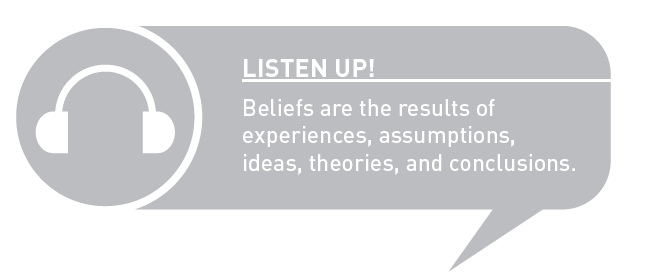
Values
Values represent the essence of what is important for the company, and as such, are often showcased prominently in corporate offices for everyone to read. Values embody what is not negotiable for the company. Values are typically included in employee onboarding documents to ensure that new employees become familiar with them upon their start in their new positions and that the new employees’ actions are consistent with them. Statements of values may include passion, excellence, innovation, motivation, and teamwork among others.
Having a values statement is a step in the right direction, but it is not enough to ensure congruence between company values and managers’ actions; managers at all levels should demonstrate these values as they conduct business every day. Let’s see an example.
A company that includes innovation in its values statement may encourage all employees to propose ideas to improve customer service. Managers may analyze employee proposals to select which ones could be implemented and attribute the success to the employee who proposed the idea. In contrast, managers could reject proposals with responses such as “we already tried that before and it did not work,” or “we do not do business that way,” thus discouraging further proposals from employees. Consequently, the value of innovation will have completely different meanings depending on how managers respond to employee efforts at creating something new. The level of support for those efforts will have an impact on employee engagement as employees tend to repeat behaviors that will produce positive outcomes for them and tend to develop an emotional attachment with entities that support them.
Employees bring their own personal beliefs and values into the workplace. Managers also select employees who have something in common with them. Be aware of this tendency. The experience of sharing these beliefs and values among all employees and managers can create strong bonds between them and can thus influence engagement because, as we have shown in the examples in this chapter, these beliefs and values will guide employees’ actions. This perceived similarity will strengthen that emotional connection with the company that will drive the employee to do more than is expected of him.
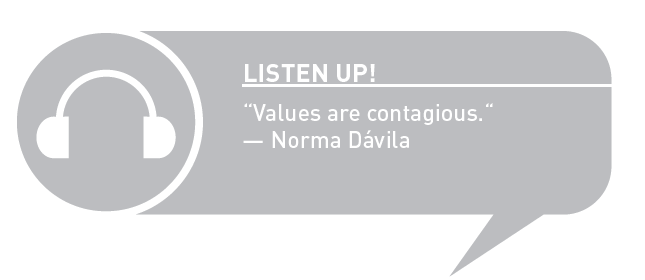
Expectations
Employees begin to form expectations about the workplace during the recruitment and onboarding processes as they learn about what the organization stands for and how it treats its employees; their experiences later either validate or destroy those initial ideas. Employee expectations are part of the psychological contract established between employee and employer that also includes the manager-employee relationship. Let’s see an example.
Todd was told during the recruitment process that he would be granted more responsibilities in projects after his 90-day probationary period. Todd’s performance during his first project contributed to its completion before the deadline and several thousand dollars under budget; his contributions were the subject of an article in the company’s newsletter. When Todd asked Sheila, his manager, about his responsibilities in his next assignment, he was surprised to learn that he would not have any new responsibilities.
After overcoming the usual disappointment associated with not receiving more responsibilities, Todd looked for ways to improve his performance and to make even more contributions in the second project to ensure that he would receive what was offered to him for the third project. Assuming that his performance in the second project is exemplary again, if Todd receives those additional responsibilities for his third project, he will conclude that his expectations were met and he will be more likely to continue driving himself to higher levels of performance. If, on the contrary, Todd’s third project includes the same level of responsibility as the previous two, he will conclude that his expectations were not met and he will either maintain a stable level of performance or his performance will begin to decline because his expectations were not met. Todd’s level of engagement will also change depending on whether or not his expectations are met.

Knowledge
Knowledge includes the technical components of the work itself as well as the unwritten rules of how to conduct business. Many employees have enough understanding of the technical side of their work as a result of their education, training, or experience; employers may provide whatever knowledge employees still need through training and other means. However, employees acquire knowledge about the unwritten rules from their managers, their peers, or their networks. Those unwritten rules are indispensable for success in any work environment and may have a greater effect on an employee’s career than subject matter expertise if they are not learned correctly and promptly. “This is how we do things at RulesForever” and “Let me show you the RulesForever way” are common phrases used during new employee onboarding. Any behavior outside of the boundaries delineated by those rules is usually not accepted and may even bring negative consequences for the wrongdoer, including exclusion from sources of information and power. Employees who feel confident about their mastery of these types of knowledge are more likely to have higher levels of engagement than those who do not.
Language
Language, in its verbal and nonverbal forms, is another important element of an organization’s culture that serves to bring together its employees because of their shared understanding of its meaning. Employees may initially feel lost when they join a company that uses multiple acronyms or shorthand to communicate; this is particularly the case when the same acronym has different industry-specific meanings. Here are some examples of acronyms that can have multiple meanings: POB can mean post office box or place of birth; NSF can denote not sufficient funds or national science foundation; OD can signify overdraft or organizational development; PM stands for project management and performance management; HR represents hour, high rate, or human resources.

Language use contributes to define group membership within a company because choice of words and vocabulary typically reflect background and experience. Let’s see an example of what happens in companies related to use of language and its impact.
Patricia is a certified Project Management Professional (PMP) and uses phrases such as phase review and free float in casual conversation. Jeremy, Patricia’s manager, does not have that certification and, even though he participated in her selection as a team member and the certification was a requirement for the position, he often interprets her word choices as a way to stand out. Jeremy is concerned about the impression that Patricia’s word choice is making on how others perceive her, because this will affect her integration into the team in a negative way. Jeremy needs to maintain team cohesion, but he cannot afford to lose a valuable resource like Patricia. As a manager, Jeremy can preserve the engagement by speaking with Patricia so that she becomes aware of the need to make herself be understood by others. Jeremy also needs to support and demonstrate that he values diversity in the team, and by doing so, he would be promoting engagement in the team.
Similarly, misinterpreting the meaning of nonverbal language used by others, such as glances and distance, may interfere with someone’s team integration and engagement. Let’s see an example.
Kim works in a cubicle environment. Upon her arrival at her work area, Kim noticed that her peers wore earplugs to work and that Nicole, her manager, needed to touch them gently on their shoulders to introduce Kim. When she asked, Nicole told Kim that the team agreed to work with earplugs as a way to maintain silence so that they could concentrate on their tasks and complete them on time. For this team, wearing earplugs was a way of saying “do not disturb,” but they were willing to make exceptions, such as when meeting a new member. By quickly learning and understanding the meaning of nonverbal cues in her team, Kim feels connected to them and, very likely, her level of engagement will increase faster than if she were feeling isolated.

Opportunities
Opportunities include options to grow and develop within a company. These may entail projects, assignments, trainings, acknowledgments, and promotions, among others. They may exist inside the company or outside of it, for example, at a professional association or other relevant group. How these opportunities become available and to whom are issues considered by employees in terms of their relationship with the company. Let’s see an example.
Your-Risk-Is-Ours Insurance prides itself in the importance of employee development and has a higher than average per capita training cost in its industry. To an outsider, Your-Risk-Is-Ours Insurance is the perfect place to work, learn, and grow. However, when the employees of Your-Risk-Is-Ours Insurance completed an engagement survey, they stated that they perceived that external candidates were preferred over internal candidates for new positions, that only members of certain groups received promotions, and that the same employees always received rewards and recognitions. Not surprisingly, their level of engagement was very low for a company of its size because its employees perceived inequities and did not see any reason to go beyond the minimum that was expected from them.
Therefore, managers need to pay special attention at availability of opportunities as an element of culture and its impact on employee engagement, as opportunities are often included in operational definitions of engagement.

Structure
Structure denotes how work is organized in the workplace. Structure influences how employees interact with each other and with their managers and supervisors, defining the real level of formality expected and accepted in those interactions. Let’s look at two examples.
PaperClipsForAll has seven management levels (team leader, supervisor, manager, assistant vice president, associate vice president, vice president, and president). All employees must address management by title and last name and all communication must be channeled through immediate supervisors. PaperClipsForAll does not have an “open door policy” because such a policy is considered a waste of valuable time and resources. At PaperClipsForAll, all employees know exactly what they need to do because their roles and responsibilities are clearly defined, as is the progressive discipline process when employees do not comply.
In contrast, RollOurOnlyWay Brands has three management levels (team leader, manager, and director) and everyone addresses everyone else by first name. At RollOurOnlyWay Brands, all employees are encouraged to communicate with anyone in the company at any time and by any means. RollOurOnlyWay Brands defines roles and responsibilities in general terms to promote flexibility and innovation in completing tasks and projects.
In these two examples, structure determines employee autonomy and defines interaction norms; in turn, these two factors lead to dissimilar levels of employee engagement for each company.
Processes and procedures are linked with structure because they establish how work is completed in organizations and guide its completion through official channels. Since employees are expected to follow processes and procedures on a daily basis, management needs to address any deviations from what is established. Very likely, employees at PaperClipsForAll are required to adhere to every detail of every procedure; while, in contrast, those at RollOurOnlyWay Brands are encouraged to challenge every procedure to find ways to complete tasks more efficiently. As we mentioned before, how work is completed is a driver of employee engagement; employees at PaperClipsForAll and RollOurOnlyWay Brands could be expected to have divergent levels of engagement.
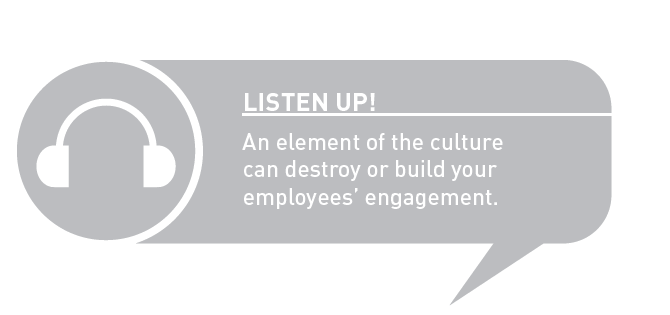
Materials
Materials refer to what resources employees have available to do their jobs. These may include, but are not limited to: equipment, computers, software, devices, uniforms, protection, furniture, and supplies. Companies decide which materials they will provide to employees and which ones they will be required to provide for themselves and under what circumstances. In some instances, employees receive stipends and other allowances to subsidize costs of materials. Let’s look at two examples of the importance of materials within organizational culture and its impact on employee engagement.
Eva is a master of technology. Imagine her in the following scenarios.
WeAreExpeditious LLC offers consulting services in technology solutions. WeAreExpeditious LLC migrates to the latest versions of software when they become available, practicing what they preach. WeAreExpeditious LLC upgrades its computers every three to five years. At the main office of WeAreExpeditious LLC, consultants have high-quality furniture and resources to work; they use office supplies on an honor system.
WeTatter4U does not change versions of programs or software until they become obsolete. Some computers at WeTatter4U have less memory than many cellphones and, consequently, cannot run many current software versions. WeTatter4U is proud of how it reuses and recycles office furniture and partitions after remodeling areas or relocating staff.
Where do you think that Eva would be more engaged?
In these two examples, access to materials and resources conveys to employees how much management values them, and, accordingly influences levels of employee engagement.
Now it’s your turn.
Worksheet 2.1 presents our depiction of the relationship between the different elements of organizational culture that we just discussed on employee engagement. On a scale of 1 to 10, where 1 has the lowest value and 10 has the highest value, assign a value to each element of culture indicating how relevant you perceive them to be as factors that influence employee engagement in your team.
Worksheet 2.1 Elements of Organizational Culture and Employee Engagement
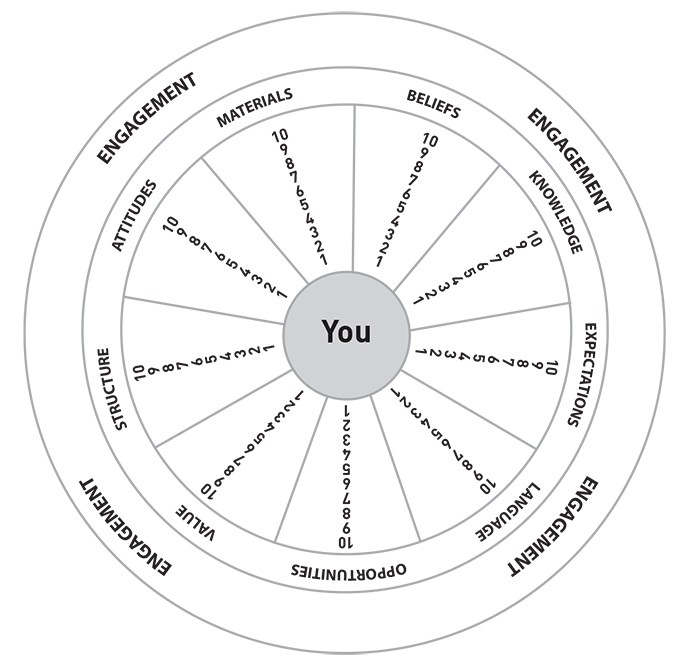
Evaluate each score and determine why you chose that score.
-
Which elements received the highest scores?
-
Which elements received the lowest scores?
-
What do you need to do to reach the desired outcomes?
Now you have a clearer picture of how your company’s culture affects your engagement. We invite you to complete the same exercise with your employees so that you can learn about how your company’s culture affects their engagement.
Please think about your company’s culture as you answer the following questions.
-
How would you describe your company’s culture as it is related to employee engagement?
- Do you agree or disagree with your company’s culture? Why?
-
How would you describe the relationship between your company’s culture and you as a manager?
-
How do you see yourself as a manager within that culture?
-
Do you know your company’s values?
-
How familiar are you with your company’s acronyms?
-
Does your company’s structure help or hinder your work as a manager? Why?
We invite you to share this exercise and its results with your employees as a way to obtain more information about what is important for them and for you about organizational culture and its impact on employee engagement.
Importance of Organizational Culture
Employees spend approximately one-third of their days at their workplaces or completing work-related activities, even if they work remotely. As a result of these working hours, employees spend more time with co-workers and managers than with their families, thus having multiple experiences in common with colleagues under relatively controlled circumstances. When employees are at work, they have common workspaces, share work breaks, use similar tools, and speak a common language, among other collective experiences. Although the Internet and social media allow employees to be exposed to a wide range of external information, many workplaces restrict access to those media during working hours. Thus, because of the exposure to external sources of information or to individuals with different backgrounds, these shared experiences have additional weight on employee perceptions of their workplaces as well as on their behavior. These shared experiences and the context where they take place play a role in modifying employee engagement. This socialization process continues and changes throughout an employee’s tenure at that employer.
Organizational culture provides direction and establishes common grounds as well as defines interactions. Through its culture, a company promotes employee teamwork and loyalty. A company also encourages retention through its reputation that is a by-product of its culture.
Now it’s your turn.
-
Do you believe that the impact of organizational culture on employee engagement stays the same or that it changes over time? Why?
-
What three steps are you taking to ensure that the culture of your company supports employee engagement?
The Relationship Between Individuals and Organizational Culture
We discussed the importance of organizational culture and shared examples of how each one of its components contributes to employee engagement. We described organizational culture as dynamic at the beginning of our discussion; we now propose that the relationship between individuals and organizational culture is also dynamic as both influence each other over time. Let’s look at an example to illustrate what we mean.
Joyce, a manager known for introducing changes gradually, recently joined HugePills Pharmaceuticals to lead its accounting department. HugePills Pharmaceuticals has a reputation of being a traditional organization. Joyce went through the typical onboarding process and soon started to hear phrases like “we have always done it this way,” and “this is how we do things in HugePills.” She also received “well-intended warnings” about how long she would last in her position if she continued asking questions to change how the department operates.
Joyce was determined to make a difference at HugePills Pharmaceuticals. She became thoroughly knowledgeable about how her department operated, ensuring the collaboration of well-respected informal leaders. She spent considerable time with her staff formally as well as informally getting to know them and developing trusting relationships with them. She learned and used the jargon of HugePills Pharmaceuticals. She identified the key operational processes where she would begin to make changes gradually and with her team’s participation.
At first, other managers resisted Joyce’s proposals and refused to follow the new procedures that she implemented, but, gradually they began to see the benefits. Even the results of the annual employee engagement survey showed improvements. Eventually, other department managers began to look at their own operational processes and procedures, thus contributing to increase overall plant efficiency.
Joyce’s example illustrates how individuals and organizational culture influence each other. Although Joyce was initially an external entity to HugePills Pharmaceuticals, similar changes can be driven by employees with longer tenure in organizations. Even though we have emphasized that an organization’s culture has an impact on employee engagement, you as a manager can make a difference by capitalizing on individual differences and monitoring your own levels of engagement.

Individual Differences Within an Organization’s Culture
Factors such as generation, gender, education, socioeconomic status, previous experience, industry, organizational level, organizational role, geographic region, family size, and community involvement, among others, may lessen or increase the effect of organizational culture. Thus, individuals will respond differently to similar components of the culture and these components may have contrasting weights on their levels of engagement. Let’s look at the stories of Jaleel and Trish who are peers at ReadyToRumble to illustrate some of these differences and what they can mean for you as a manager as you promote employee engagement.
Jaleel started working at ReadyTwoRumble as an intern in college, obtained an entry-level position, worked for three years in one department, and recently joined the shipping department to work on a project. Jaleel’s entire career has been at ReadyTwoRumble and he is very loyal to the organization for what it has given him throughout the years. Jaleel speaks highly of ReadyTwoRumble wherever he has an opportunity to do so and encourages others to seek employment there. He is used to working long hours because their systems are at the top of their capacity and generating reports for senior management can take a lot of time; his family is used to his absence. Jaleel intends to continue working at ReadyTwoRumble until his retirement.
Trish worked in three other organizations before joining ReadyTwoRumble. She completed an internship as an exchange student in Japan, where she learned to speak Japanese. She then obtained an entry-level position and soon after became a team leader. ReadyTwoRumble recruited Trish because of her contributions and expertise. Until Trish started at ReadyTwoRumble, she only worked long hours when it was absolutely necessary because time with her family is very important to her. She is very technology savvy and uses it to maintain her productivity at very high levels, but the systems available at ReadyTwoRumble are becoming an obstacle in her performance. Trish is disappointed with the company and regrets not having asked more questions about technology and other resources before accepting their offer; she is already looking for another opportunity elsewhere.
Jaleel and Trish work at the same company and are subject to the effects of its culture. However, because of the differences in their backgrounds, the impact of a single element—the availability of technology—has a dissimilar consequence on each one of them. What is “business as usual” for Jaleel is totally unacceptable for Trish; therefore, their levels of engagement are totally opposite because of the “I” element. If you were their manager, you would need to work with those differences to help Jaleel to maintain his high levels of engagement and to find a way to increase Trish’s level of engagement.
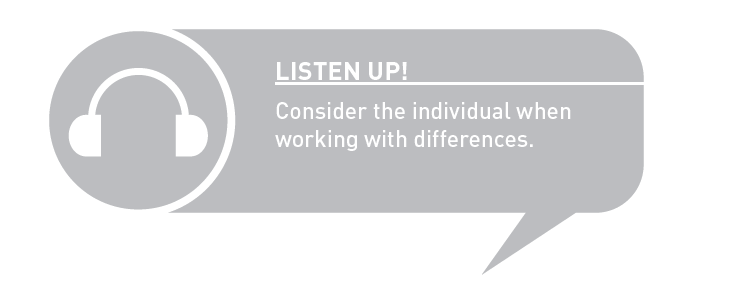
Now it’s your turn.
Let’s look at individual differences in your team.
-
Which individual differences are present in your team?
-
How are these individual differences having an impact on your employees’ engagement?
-
What are you doing to address those differences to increase employee engagement?
Role of the Manager in the Organization’s Culture
As a manager, you embody your company’s culture for your employees, as they will interpret everything that you do and communicate as representative of your company and of its ways of working. You continuously contribute to shape that culture, as well as employee engagement, along with other levels of management in your company. You are uniquely positioned to either maintain your organization’s culture or to begin to change it, because, whether you intend to or not, you lead by example.
Based on our experience working with clients from different industries, we propose that you could be a company’s culture Bodyguard, Steady One, or Transformer. Let’s look at how each one functions within a company’s culture and how they contribute to foster employee engagement within that role.
- The Bodyguard is absolutely convinced that the company’s culture is perfect as it is and proudly displays symbols of the company on clothing (for example, wearing a company pin) and in workspace (such as through pictures with senior management). The Bodyguard constantly reinforces the way to do business at the company to new employees at all levels, announcing her multiple years of service at every possible opportunity. The Bodyguard is often someone known and admired across organizational levels. Typically, the Bodyguard has held different positions of increasing responsibility over time and cannot even imagine what it would be like to work elsewhere. The Bodyguard defends the company vehemently from any perceived or real attack coming from an outsider or from a new employee. She strives to maintain the company’s culture at all costs, and sometimes misses opportunities to innovate and make things better because of an unspoken fear of losing control. The Bodyguard promotes employee engagement through heightening organizational brand and image as well as through consistent communication. She may use performance management to perpetuate those employee behaviors that she believes to be appropriate for the company and extinguish those behaviors that she does not approve, thus, perhaps inadvertently, engendering polar opposites of employee engagement within the team.
-
- The Steady One understands the company’s culture. He flows with changes over time, but very slowly. The Steady One may or may not have had experiences in other companies, but has stayed in the current one longer than the average manager. The Steady One has a long-term perspective on how the culture could be, but will not take any radical steps in that direction. Instead, he analyzes any project for its potential impact before deciding to support it and does so only if there is a very high degree of certainty for its success. The Steady One only supports employee initiatives that have undergone intensive scrutiny to minimize risk of failure for the employee as well as for himself. Even though the Steady One is a good source of information about the company’s history and culture, his input is rarely sought. The Steady One hopes to stay in his current company until the end of his career and fears obsolescence if the culture changes dramatically. The Steady One promotes employee engagement through consistent communication that heighten the importance of careful analysis before taking action. He will pay considerable attention to detail during all activities related to performance management and will be very cautious when considering career opportunities for team members. In the end, the impact of the Steady One on employee engagement will also depend on the natural predisposition of the members of the team.
-
- The Transformer has a thorough understanding of the company’s culture, but is able to look at it critically to identify what can be done better. Like the Bodyguard, the Transformer proudly displays symbols of the company and defends it, but the Transformer is very careful about not conveying fanaticism in expressions of loyalty because he knows that eventually he will go somewhere else to work. The Transformer is well known throughout the company, but has also held different positions in other companies. Others seek his opinions because they tend to be based on facts and trends instead of emotions; he is not blind to the shortcomings of the company’s culture. The Transformer looks for information about best practices in other organizations and finds ways to adapt them so that they can be implemented quickly in his. The Transformer supports employee efforts to create and innovate within the boundaries of the company, even when doing so may mean tolerating and correcting mistakes. He empowers employees to make decisions, take risks, and make a difference. The Transformer encourages employee engagement mainly through leadership and communication as well as performance management, assuming responsibility for every outcome and supporting his employees in their journey.
Every organization needs Bodyguards, Steady Ones, and Transformers because they meet different needs at different moments in time. However, companies may tend to favor one over the other depending on what they do and how they do it. For example, you may find more Bodyguards in conservative industries such as banking and finance. In contrast, high-technology companies may have greater numbers of Transformers because they thrive on change and innovation.
Although we have presented the Bodyguard, Steady One, and Transformer of organizational culture from a manager’s perspective, you may find variations of these three personas among the members of your team. We invite you to see how your persona is similar or different from that of the other members of your team.
A manager usually leads a team that already exists. If this is your situation, you will be addressing the needs of each member of your team to promote their engagement and, as you will see in other chapters of this book, you will need to consider where they are in their engagement process in your company and in their careers overall. However, you may participate in the recruitment and selection of new employees for your team or company. Because this process is the foundation for the company’s culture of the future, we encourage you to take advantage of the opportunity to make a difference and “interview for engagement,” asking questions about likes and dislikes as well as competencies. You will look for evidence of a positive predisposition toward the workplace in these interviews, which will only be the first step in the process of establishing that strong emotional connection necessary for an employee to become highly engaged.
In another chapter we describe a series of typical steps in the employee engagement process within a company. Before we close this chapter, we would like you to think about what we discussed in this last section.
Now it’s your turn.
-
What do you think that the Bodyguard, Steady One, and Transformer personas can contribute to the culture of your workplace?
-
How does each one contribute to the success of your team?
-
Which one of the three personas resembles mostly how you are currently contributing to the culture of your workplace? Why?
-
What cultural needs have not been met by the Bodyguard, the Steady One, and the Transformer?
-
What can you do to address those needs?
KEY POINTS AND TAKEAWAYS
-
Organizational culture encompasses attitudes, beliefs, expectations, knowledge, language, opportunities, structure, and materials.
-
Beliefs are internal representations of events.
-
Attitudes play a critical role in employee engagement; they include emotional, behavioral, and cognitive components.
-
Values embody what is not negotiable for the company.
-
Employees bring values and beliefs into their workplaces.
-
Expectations are part of the psychological contract.
-
Those unwritten rules that are indispensable for success are part of knowledge.
-
Take verbal and nonverbal language into consideration in communication.
-
Opportunities are often included in the engagement equation.
-
Structure influences how employees interact.
-
Be aware of the resources needed.
-
Bodyguard, Steady One, and Transformer—you need all three of them.
